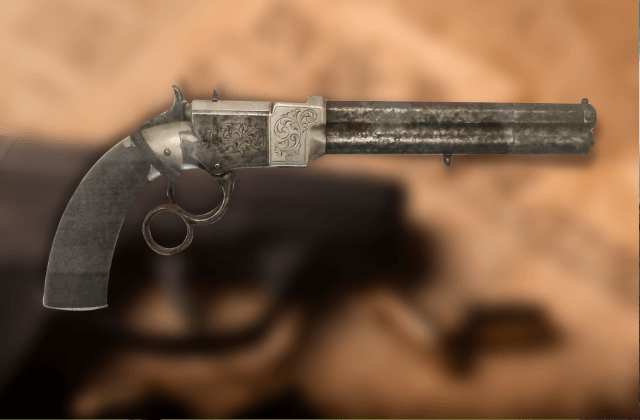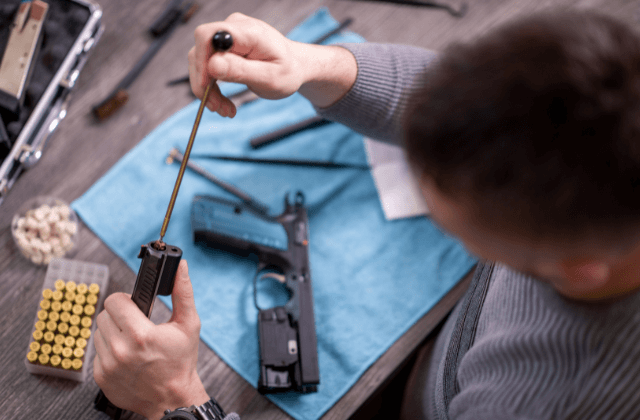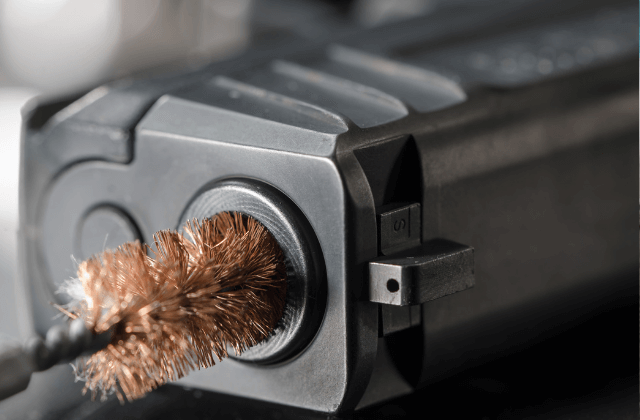This site contains affiliate links. As an Amazon Associate, I earn a commission from qualifying purchases at no extra cost to you. Full Disclosure Here.
Anything made of iron can rust, and guns tend to have a whole lot of iron. So, rust is pretty much unavoidable. And rust doesn’t just make your gun look bad; if there’s too much, it can seriously damage your gun.
Fortunately, it’s usually pretty easy to both eliminate and help prevent rust in the first place. In this guide, we’ll go over a couple of different methods for removing rust from your firearm and a few different methods to help prevent the development of rust.
But first, let’s talk about how rust develops in the first place.
How Does Rust Form on Your Gun?
Since almost all firearms rely on iron components to function, rust is an inherent risk. Even firearms that use aluminum or other metals that don’t rust for the frame or barrel still almost always contain internal components that contain iron.

But why does rust happen in the first place?
Basically, rust occurs because of oxidation. Oxidation happens when iron (including alloys that contain iron) is exposed to water and oxygen. (Note that other metals, like aluminum, can still corrode due to oxidation, the corrosion just isn’t rust).
In the context of guns, rust can occur because your gun gets dropped in water or splashed, but it can also be due to humidity in the air surrounding your gun.
In fact, the latter is probably the more common cause of rust, especially if you’re like me and live in an especially humid area. Saltwater is particularly bad for causing rust, so those who live in coastal areas should be especially wary.
Rust is also common on guns used for hunting or at outdoor ranges since they’re exposed to more humidity and precipitation. Carry guns are also more likely to experience rust since they’re stored close to the body, where they can pick up salt and moisture from your sweat.
Most of the time, when you see rust on your gun, it should just be fine bits that almost look like dust. However, rust can certainly become more severe, especially if you forego routine cleaning and other maintenance or improperly store your firearm.
If left unchecked, rust can eat away at the metal components of your firearm, causing permanent damage.
Rust is especially an issue if it’s on the interior of the barrel, where it can even cause your gun to explode if it compromises the barrel’s integrity. It also becomes a problem if it damages any of the various moving components since that can inhibit the firearm’s ability to function.
Some modern firearms have coatings to prevent rust, like anodizing and Cerakote. Bluing is an older take on the same concept. However, these coats aren’t perfect and aren’t a substitute for good maintenance. They can become damaged and wear down over time, leaving your gun open to rust damage.
How to Remove Rust off a Gun
Now let’s get down and dirty with a few different methods for removing rust from a gun.
Basic Cleaning with Solvent
If you only have a little bit of rust to remove, cleaning rust off is pretty easy.
First, check to ensure your firearm is empty, checking both the chamber and the magazine before disassembling the firearm as much as possible. Make sure you know how to put it back together once you’re done.

Wipe down the various parts with a solvent on a soft cloth. For surface rust, you can use either a CLP or a dedicated solvent. Whatever you choose, work the solvent or CLP into any nooks and crannies with a toothbrush or all-purpose brush.
If there are any slightly stubborn patches, you can let the solvent sit for up to an hour, then you can work at them with a stiff brush.
CLPs are handy because they’re an all-in-one solution that contains a cleaner, lubricant, and protectant in a single product. My go-to CLP is from Sage & Braker, but Clenzoil and Break Free are also great options.
However, CLPs are not typically as good at any one of those jobs as a dedicated product, so it might be easier to use a cleaning solvent and then follow it up with a gun oil for lubrication and protection once you’re finished, especially for more stubborn rust.
As far as solvents go, my top picks are Hoppe’s No. 9 Gun Bore Cleaning Solvent (a classic for good reason) and M-Pro 7 Gun Cleaner.
Once you’ve removed all the rust, follow up with a thin coat of gun oil to prevent the development of any more rust. Make sure not to apply too much, or it can pick up dust and lint, which gums up the inner workings of your gun.
Cleaning More Stubborn Rust
If you try the basic cleaning method and there are still stubborn rusty patches clinging on, you can try attacking them with steel wool or a steel brush. Let the solvent sit for up to an hour, then scrub the area with fine steel wool or a stiff steel brush.
Be careful using abrasive methods if your gun has blueing, as abrasion can damage the blued finish. If you have stubborn rust on a gun with blueing, skip to the next step.
If These Methods Aren’t Working
If you can’t remove the rust using the above methods, you still have a couple more options.
First, if the rust is so severe that parts are damaged beyond working condition, you’ll simply need to replace them.
Fortunately, most parts of a firearm are easy to replace, especially newer firearms, since they tend to be more modular. There are also plenty of tutorials online, in both written and video form, to make this even easier.
If you’re not comfortable replacing parts or aren’t certain of the extent of the damage, you’ll probably want to take your gun to an experienced gunsmith. They’ll have tools and experience that you don’t and may be able to restore the firearm safely. Unfortunately, this may require replacing some parts, but a good gunsmith will hopefully be able to put it back into working condition.

Remember, you can actually damage your firearm accidentally by being too aggressive while trying to remove rust, so when in doubt, see a pro.
Preventing Rust in the First Place
You may have heard the old adage, “an ounce of prevention is worth a pound of cure,” and it holds true with guns and rust too. The best way to ensure that you don’t damage your gun when removing rust is by preventing the development of rust in the first place.
Fortunately, it’s usually pretty easy to prevent rust. Just make sure you’re properly cleaning your firearm between uses. Ensure you’re following up after cleanings with gun oil to help protect your firearm from humidity. It’s especially important to take care to regularly clean guns that are carried or used outdoors since they’re exposed to even more moisture than other weapons.
Take care when storing your firearms too. All kinds of dehumidifiers and desiccants can be placed in gun cases and safes to help cut humidity, keeping your firearms nice and dry. And you can use range bags while traveling.
FAQs
You can use any of the above methods to refresh a rusted weapon. The easiest and most straightforward way to remove rust from a firearm is by applying a gun solvent. However, more severe rust may require more elbow grease.
Unfortunately, any type of gun with iron or iron alloy pieces is at risk for rust damage. The type of gun isn’t as important as how you care for and maintain it. Aluminum doesn’t rust, but it does oxidize in other ways, and even aluminum-framed firearms still usually have iron or iron alloy components.
Never shoot ammunition with rust or any other form of corrosion, especially if it goes beyond the bullet’s surface. Instead, safely discard the ammunition. The best way to do that varies depending on where you are, so contact your local police department (using their non-emergency number) or municipal waste facility to find out how ammunition should be disposed of.
Conclusion
By now, you should have all the information you need to clean rust off your gun.
Fortunately, it’s generally a very easy process with the right products and some elbow grease.
When that doesn’t work, taking your gun to an experienced gunsmith is an easy way to ensure that your firearm is put back into working condition without risking damaging the gun further with more aggressive rust removal methods.
And don’t forget that prevention goes a long way. It may feel like a chore, but it’s worth it to make proper cleaning and storage part of your routine, especially for hunting and carry weapons that are exposed to more moisture.

